Page 3 of 157
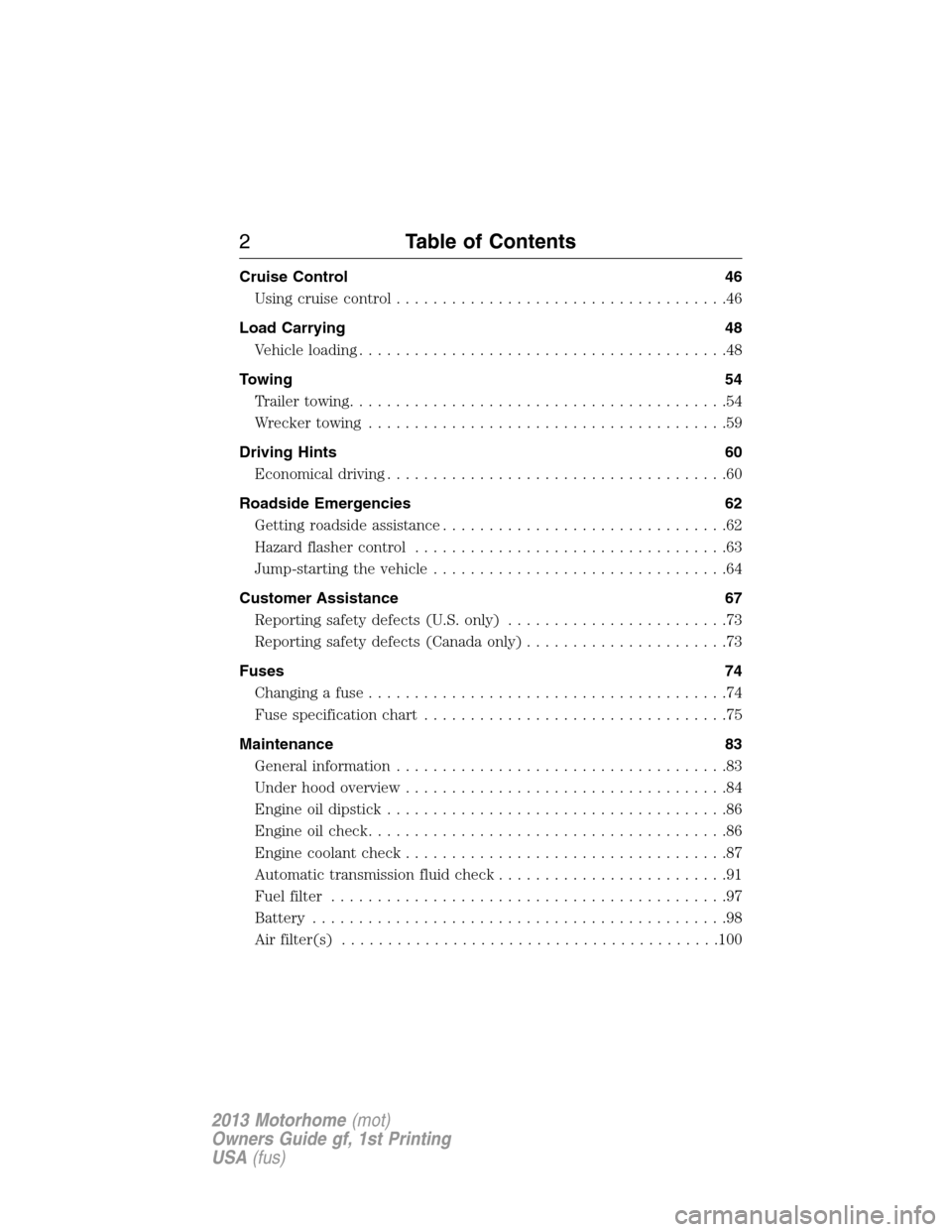
Cruise Control 46
Usingcruisecontrol....................................46
Load Carrying 48
Vehicle loading........................................48
Towing 54
Trailertowing.........................................54
Wrecker towing.......................................59
Driving Hints 60
Economical driving.....................................60
Roadside Emergencies 62
Getting roadside assistance...............................62
Hazard flasher control..................................63
Jump-starting the vehicle................................64
Customer Assistance 67
Reporting safety defects (U.S. only)........................73
Reporting safety defects (Canada only)......................73
Fuses 74
Changing a fuse.......................................74
Fuse specification chart.................................75
Maintenance 83
General information....................................83
Under hood overview...................................84
Engine oil dipstick.....................................86
Engine oil check.......................................86
Engine coolant check...................................87
Automatic transmission fluid check.........................91
Fuel filter...........................................97
Battery .............................................98
Air filter(s).........................................100
2Table of Contents
2013 Motorhome(mot)
Owners Guide gf, 1st Printing
USA(fus)
Page 17 of 157
GAUGES
A. Engine oil pressure gauge
B. Tachometer
C. Information display. SeeInformation displaysfor more information.
D. Speedometer. Vehicle speed is limited to either 65 mph (105 km/h) or
75 mph (120 km/h).
E. Transmission fluid temperature gauge
F. Engine coolant temperature gauge
G. Fuel gauge
Engine Oil Pressure Gauge
Indicates engine oil pressure. The needle should stay in the normal
operating range (between “L” and “H”). If the needle falls below the
normal range, stop the vehicle, turn off the engine and check the engine
oil level. Add oil if needed. If the oil level is correct, have your vehicle
checked by your authorized dealer.
ABDEC
GF
16Instrument Cluster
2013 Motorhome(mot)
Owners Guide gf, 1st Printing
USA(fus)
Page 18 of 157
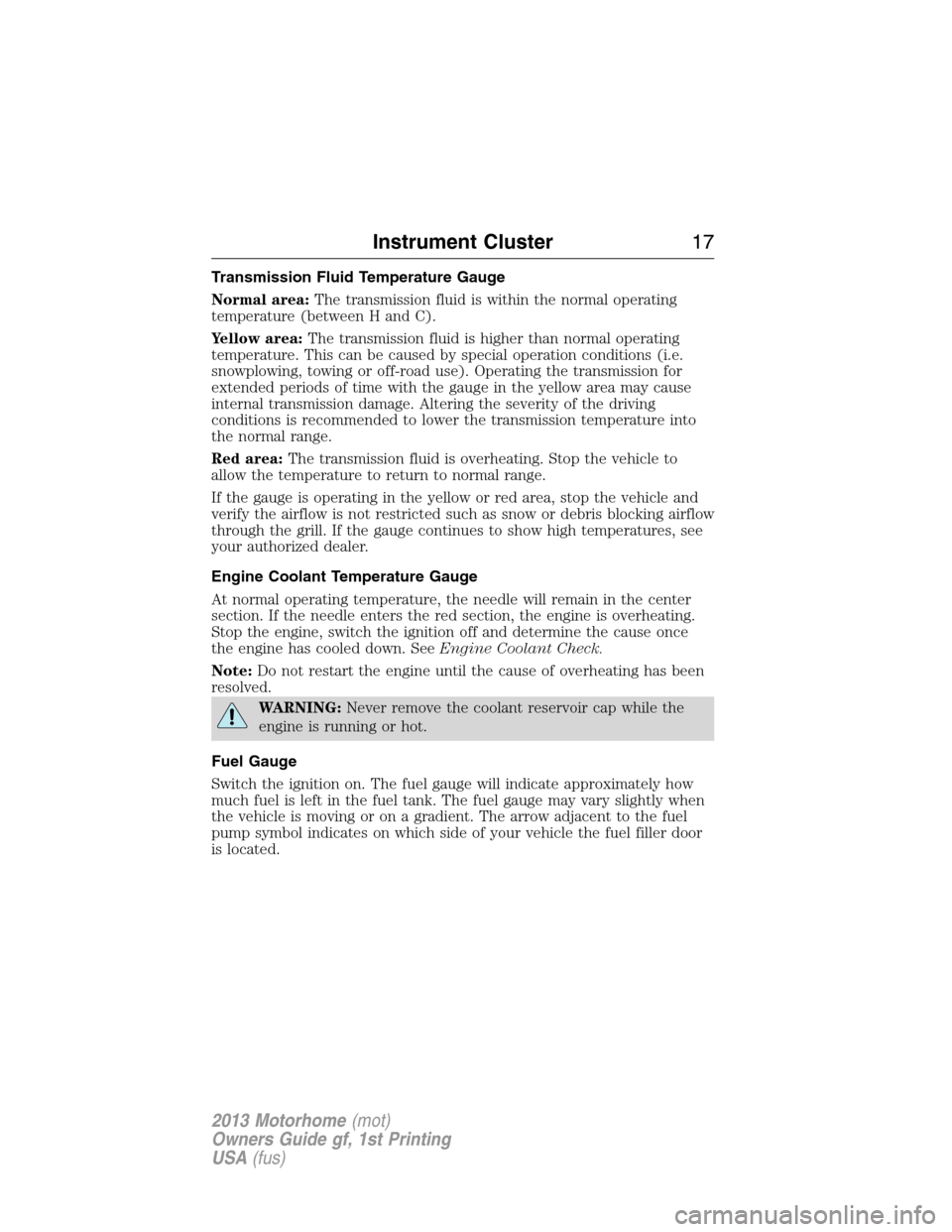
Transmission Fluid Temperature Gauge
Normal area:The transmission fluid is within the normal operating
temperature (between H and C).
Yellow area:The transmission fluid is higher than normal operating
temperature. This can be caused by special operation conditions (i.e.
snowplowing, towing or off-road use). Operating the transmission for
extended periods of time with the gauge in the yellow area may cause
internal transmission damage. Altering the severity of the driving
conditions is recommended to lower the transmission temperature into
the normal range.
Red area:The transmission fluid is overheating. Stop the vehicle to
allow the temperature to return to normal range.
If the gauge is operating in the yellow or red area, stop the vehicle and
verify the airflow is not restricted such as snow or debris blocking airflow
through the grill. If the gauge continues to show high temperatures, see
your authorized dealer.
Engine Coolant Temperature Gauge
At normal operating temperature, the needle will remain in the center
section. If the needle enters the red section, the engine is overheating.
Stop the engine, switch the ignition off and determine the cause once
the engine has cooled down. SeeEngine Coolant Check.
Note:Do not restart the engine until the cause of overheating has been
resolved.
WARNING:Never remove the coolant reservoir cap while the
engine is running or hot.
Fuel Gauge
Switch the ignition on. The fuel gauge will indicate approximately how
much fuel is left in the fuel tank. The fuel gauge may vary slightly when
the vehicle is moving or on a gradient. The arrow adjacent to the fuel
pump symbol indicates on which side of your vehicle the fuel filler door
is located.
Instrument Cluster17
2013 Motorhome(mot)
Owners Guide gf, 1st Printing
USA(fus)
Page 26 of 157
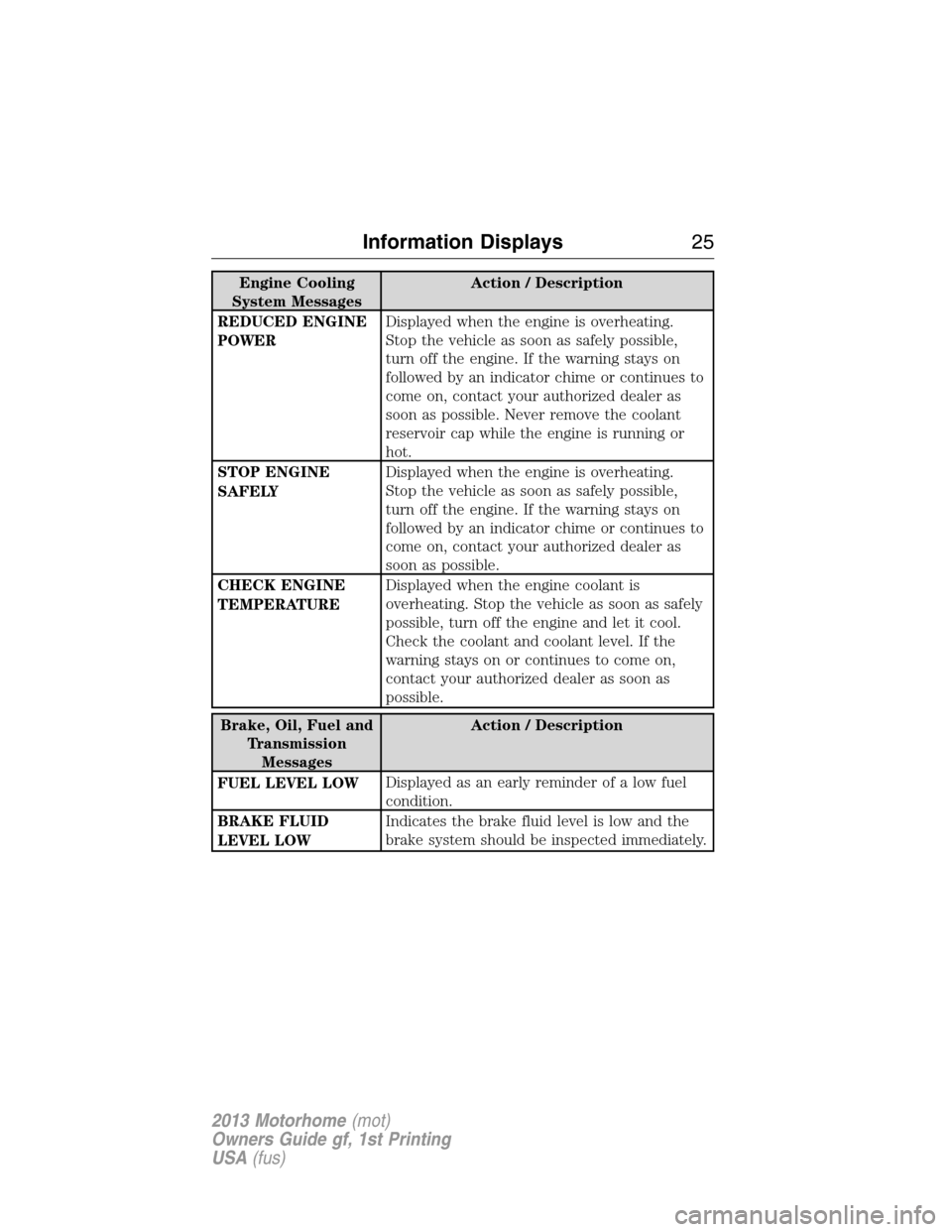
Engine Cooling
System MessagesAction / Description
REDUCED ENGINE
POWERDisplayed when the engine is overheating.
Stop the vehicle as soon as safely possible,
turn off the engine. If the warning stays on
followed by an indicator chime or continues to
come on, contact your authorized dealer as
soon as possible. Never remove the coolant
reservoir cap while the engine is running or
hot.
STOP ENGINE
SAFELYDisplayed when the engine is overheating.
Stop the vehicle as soon as safely possible,
turn off the engine. If the warning stays on
followed by an indicator chime or continues to
come on, contact your authorized dealer as
soon as possible.
CHECK ENGINE
TEMPERATUREDisplayed when the engine coolant is
overheating. Stop the vehicle as soon as safely
possible, turn off the engine and let it cool.
Check the coolant and coolant level. If the
warning stays on or continues to come on,
contact your authorized dealer as soon as
possible.
Brake, Oil, Fuel and
Transmission
MessagesAction / Description
FUEL LEVEL LOWDisplayed as an early reminder of a low fuel
condition.
BRAKE FLUID
LEVEL LOWIndicates the brake fluid level is low and the
brake system should be inspected immediately.
Information Displays25
2013 Motorhome(mot)
Owners Guide gf, 1st Printing
USA(fus)
Page 27 of 157
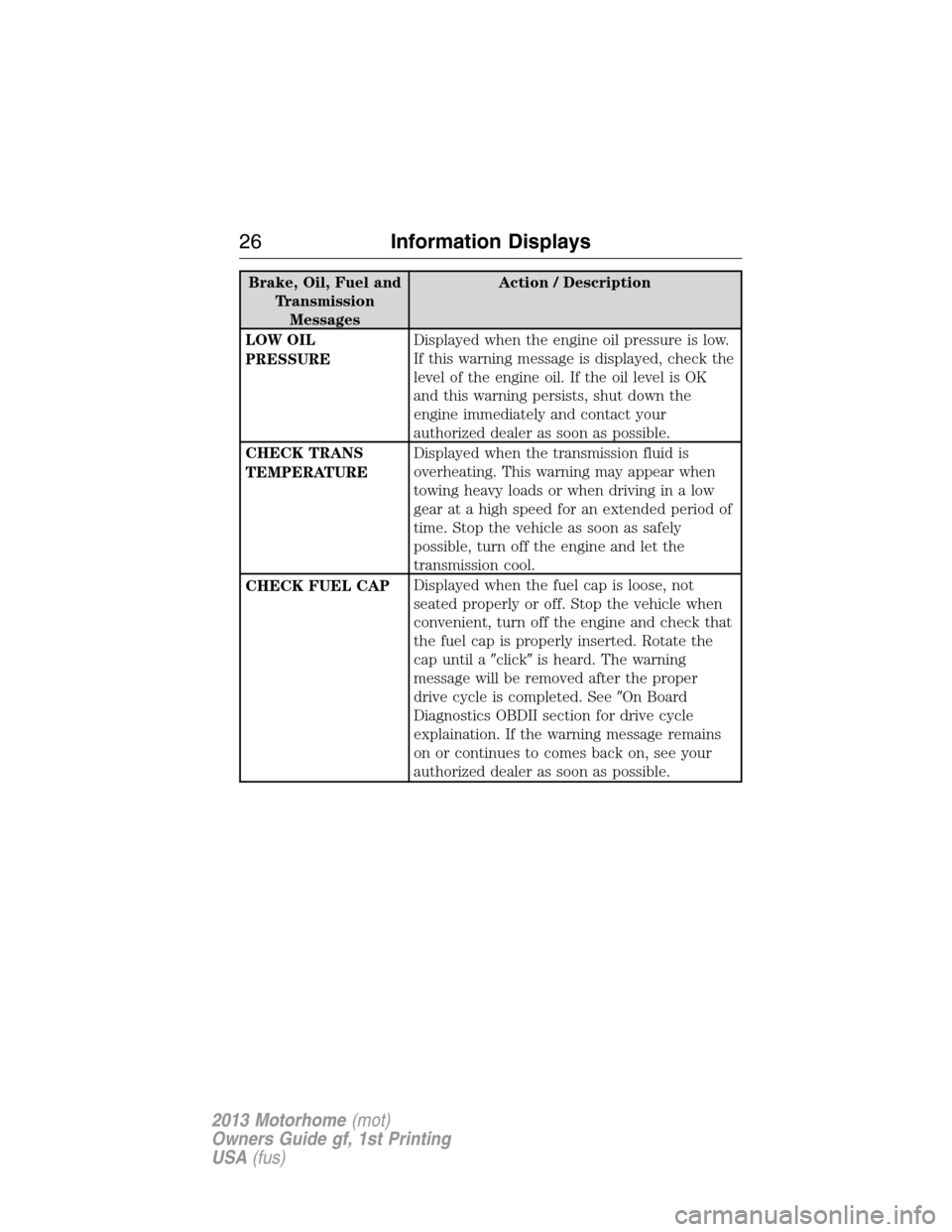
Brake, Oil, Fuel and
Transmission
MessagesAction / Description
LOW OIL
PRESSUREDisplayed when the engine oil pressure is low.
If this warning message is displayed, check the
level of the engine oil. If the oil level is OK
and this warning persists, shut down the
engine immediately and contact your
authorized dealer as soon as possible.
CHECK TRANS
TEMPERATUREDisplayed when the transmission fluid is
overheating. This warning may appear when
towing heavy loads or when driving in a low
gear at a high speed for an extended period of
time. Stop the vehicle as soon as safely
possible, turn off the engine and let the
transmission cool.
CHECK FUEL CAPDisplayed when the fuel cap is loose, not
seated properly or off. Stop the vehicle when
convenient, turn off the engine and check that
the fuel cap is properly inserted. Rotate the
cap until a�click�is heard. The warning
message will be removed after the proper
drive cycle is completed. See�On Board
Diagnostics OBDII section for drive cycle
explaination. If the warning message remains
on or continues to comes back on, see your
authorized dealer as soon as possible.
26Information Displays
2013 Motorhome(mot)
Owners Guide gf, 1st Printing
USA(fus)
Page 46 of 157
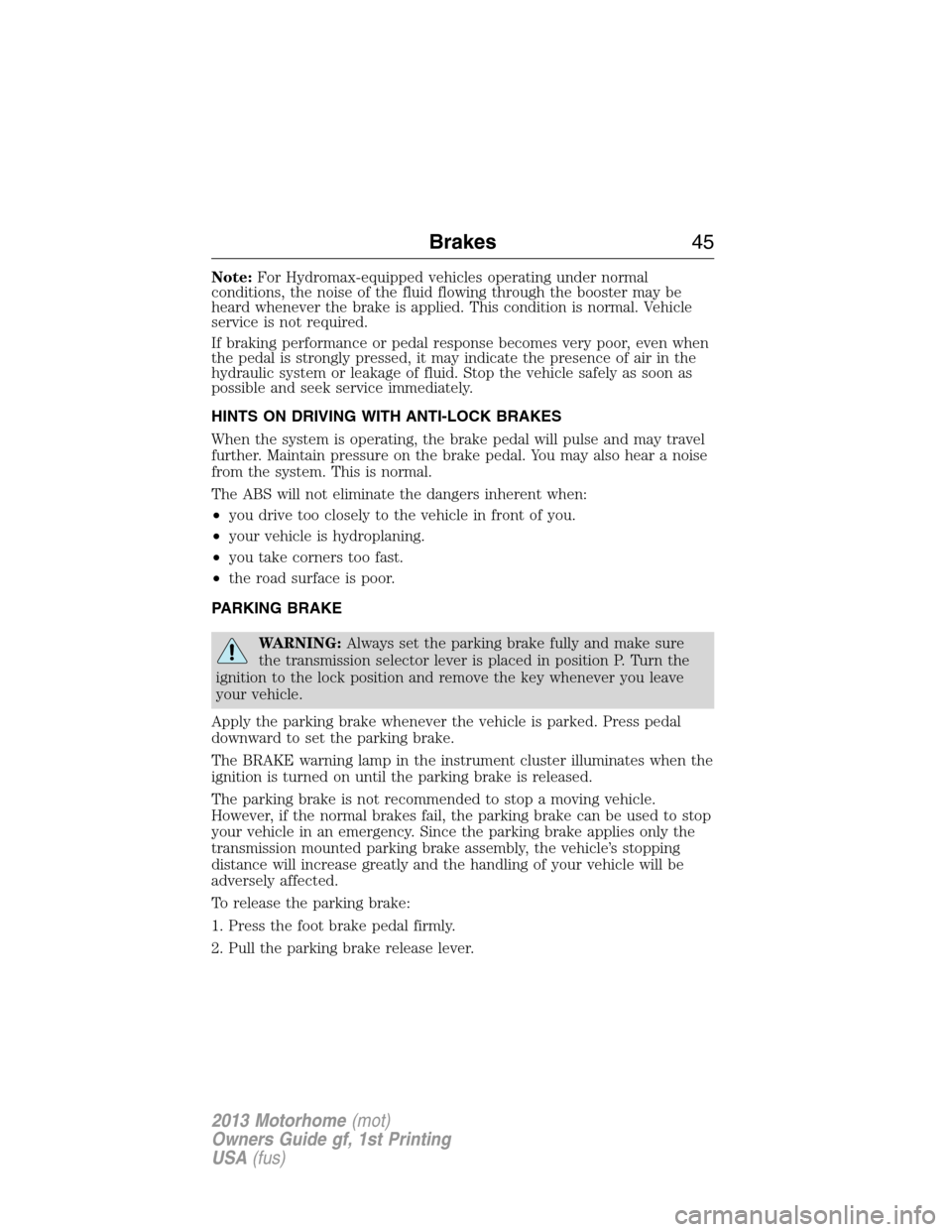
Note:For Hydromax-equipped vehicles operating under normal
conditions, the noise of the fluid flowing through the booster may be
heard whenever the brake is applied. This condition is normal. Vehicle
service is not required.
If braking performance or pedal response becomes very poor, even when
the pedal is strongly pressed, it may indicate the presence of air in the
hydraulic system or leakage of fluid. Stop the vehicle safely as soon as
possible and seek service immediately.
HINTS ON DRIVING WITH ANTI-LOCK BRAKES
When the system is operating, the brake pedal will pulse and may travel
further. Maintain pressure on the brake pedal. You may also hear a noise
from the system. This is normal.
The ABS will not eliminate the dangers inherent when:
•you drive too closely to the vehicle in front of you.
•your vehicle is hydroplaning.
•you take corners too fast.
•the road surface is poor.
PARKING BRAKE
WARNING:Always set the parking brake fully and make sure
the transmission selector lever is placed in position P. Turn the
ignition to the lock position and remove the key whenever you leave
your vehicle.
Apply the parking brake whenever the vehicle is parked. Press pedal
downward to set the parking brake.
The BRAKE warning lamp in the instrument cluster illuminates when the
ignition is turned on until the parking brake is released.
The parking brake is not recommended to stop a moving vehicle.
However, if the normal brakes fail, the parking brake can be used to stop
your vehicle in an emergency. Since the parking brake applies only the
transmission mounted parking brake assembly, the vehicle’s stopping
distance will increase greatly and the handling of your vehicle will be
adversely affected.
To release the parking brake:
1. Press the foot brake pedal firmly.
2. Pull the parking brake release lever.
Brakes45
2013 Motorhome(mot)
Owners Guide gf, 1st Printing
USA(fus)
Page 85 of 157
UNDER HOOD OVERVIEW
6.8L V10 engine
1. Engine coolant reservoir
2. Engine oil filler cap
3. Automatic transmission fluid dipstick
4. Power distribution box
5. Air filter assembly
6. Engine oil dipstick
7. Brake fluid reservoir
8. Power steering fluid reservoir
12345768
84Maintenance
2013 Motorhome(mot)
Owners Guide gf, 1st Printing
USA(fus)
Page 86 of 157
6.8L V10 engine (commercial stripped chassis)
1. Engine coolant reservoir
2. Engine oil filler cap
3. Automatic transmission fluid dipstick
4. Power distribution box
5. Engine oil dipstick
6. Brake fluid reservoir
7. Air filter assembly
8. Power steering fluid reservoir
12345678
Maintenance85
2013 Motorhome(mot)
Owners Guide gf, 1st Printing
USA(fus)